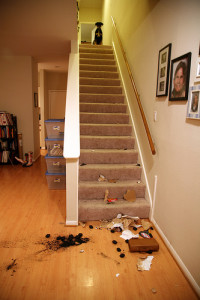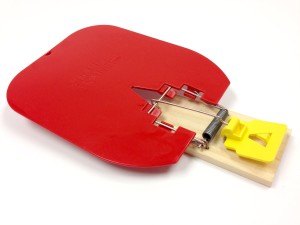
Now, I don’t know about you, but it seems like every dog I’ve had since I was a kid has had an awful fascination with getting in the trash. My German Shepherd, Bronco, has developed an addiction to getting into the trash. I try to tell myself it’s because he was a stray and so he’s used to raiding smelly trash and eating stuff (so that I don’t lose my temper.)His favorite thing to get out of the trash is, of course, anything with bacon. Secondarily, he enjoys popcorn bags. Probably the weirdest thing he ate though was some chilies that I had roasted and my husband accidentally threw away the plastic bag. Bronco pulled that right out and chewed through the bag to down those green chilies (we were very lucky there was no explosive diarrhea afterward.)
Anyway, keeping a dog out of the trash can seem like hopeless venture. By the time you notice, they’ve already gotten in, rewarded themselves for doing it and have forgotten what happened. Then you find the mess and tear out your hair in frustration as you berate them. They consequently look guilty, despite not having any idea why you’re yelling at them. And so it keeps happening. You may catch your dog in the act of getting in the trash and punish them, but they merely move to doing it when you’re not around instead.
The problem with your dog getting into the trash is that it’s a self-rewarding behavior. The dog gets in the trash and they immediately get rewarded with delicious leftovers. You can’t always be there to keep him out of the trash.
So what can you do if yelling at your dog doesn’t keep them from getting in trash? Here are some suggestions:
Lock It Up, Duh.
Whether you close off the kitchen with a baby gate, put the trash in a child-locked cabinet, in your pantry, or in a dog proof trash can, locking up your scraps is a good way to keep your dog out of the trash. I have my trash in my pantry, but I am still seriously working on remembering to shut the door. Unfortunately, this often means trash everywhere when I get back.
If you want to go the dog proof trash can route, see my article on dog proof trash cans. Totally worth every penny.
Environmental Deterrents
 Environmental deterrents are basically traps that you set up for your dog to scare them (not hurt them!) For counter surfing, for example, you can often set up a can full of pennies tied to something delicious on the edge of a counter that will fall off and make lots of noise. With trash cans, you have to use some specialty products. These are really the best ones to use if you haven’t gotten a specialty trash can.
Environmental deterrents are basically traps that you set up for your dog to scare them (not hurt them!) For counter surfing, for example, you can often set up a can full of pennies tied to something delicious on the edge of a counter that will fall off and make lots of noise. With trash cans, you have to use some specialty products. These are really the best ones to use if you haven’t gotten a specialty trash can.
Scat Mat – 4.5 stars on Amazon. This product works super well to deter your pet from going places they shouldn’t be. If you can set your trashcan in a corner and put this mat in front of it, your dog will quickly learn to stay out of the trash. This product works by giving your dog a low static pulse for three seconds. Enough to scare them off.
Snappy Trainer – Decent ratings at Amazon. Seems to work well for most people. This is basically a mousetrap with a soft plastic flap on it that makes a lot of noise when triggered. Would be a great thing to set in the trash on top of bacon.
The ASPCA has this thorough article about environmental deterrents too, if you want more specifics.
Train It

Photo Credit: Sarah Camp cc
Dogs that are used for protection or as service dogs are often trained to not eat food without permission from their owners. I remember seeing this for the first time when I was learning to train my German Shepherd as a teen. The man I was learning from trained protection and Schutzhund and he showed me how his Dutch Shepherd could have delicious hot dogs thrown at her feet and she wouldn’t even sniff them until he gave her a command. It does come across as a bit controlling, but if you’ve got a dog getting in the trash, it’s probably a much better option than having trash strewn around the house because you forgot to take it out or lock it up.
To train this, you need to work it up from easy to hard. Many methods out there require you to use a corrective collar, but I feel like this could be easily trained by using a cue to take food.
Remember, if your dog fails a step, go back to the step prior and practice for longer before you move forward again.
In basic form, start like this:
1) Hold a tasty treat in your hand (probably with a leather glove on) and hold it in a fist in front of your dog’s nose. He will likely try to get it from your hand. Don’t let him.
2) When he gets frustrated enough to back off, click or praise and open your hand to allow the dog to get the treat while giving a command like “eat up”.
3) As you practice, make him back off for longer amounts of time before you open and let him have the treat.
4) As you train this, begin doing the same thing before the dog is allowed to eat from their bowl. Hold the bowl up until the dog sits and waits, then slowly lower the bowl. If the dog hops up, give a quick “leave it” command, pull the bowl back up high until the dog sits and waits again. Once the dog sits and waits long enough for you to put the food on the ground, say your command “eat up”.
5) As you continue training the sit and wait for breakfast/dinner, you will teach the dog to wait for longer periods of time before you release them with an “eat up”.
6) Once the dog gets the hang of the two commands, you can start training it with your dog on leash and the treat or food on the ground. Don’t allow them to get close to the food until they stop pulling and look to you for the command.
7) At this point, you will start working on not always releasing them to eat the food and instead rewarding them from your hand.
8) After your dog has gotten to the point where you can walk past a piece of food on the ground on leash without them trying to pick it up without your release, you can start training it on distance, with you further away, but with the dog still on leash.
9) Remember, you can increase distance or time each session, but don’t do both at the same time.
10) Finally, start training off leash. If the dog makes a mistake, move back in the training back on leash.
11) Have other people try to give the dog food, but only allow the dog to take it on command (and make sure they are OK taking the food from the stranger,as long as the stranger gives the command)
12) Start proofing with the trash, by going through the same steps with strong smelling food in the trash or on the counter, always rewarding from the hand and alternately with verbal/physical praise as you begin to phase out treats.
13) When the dog is well proofed with you in the room, begin proofing by leaving food out, leaving the dog in the room with food and going around the corner. Come back into the room and reward/praise. Start with short durations, and once the dog is well-proofed, increase the duration until you can leave the room for long periods of time with no trouble. Then proof by going out of the house with the same duration increase (very short in and out to long durations.)
14) Hooray! Your dog is now trained to not eat food except on command. After the dog is well trained, you can begin to phase out rewards entirely and use breakfast/dinner as a reinforcer of the lesson.
So tell me, what’s the weirdest thing your dog has gotten into the trash to eat?
